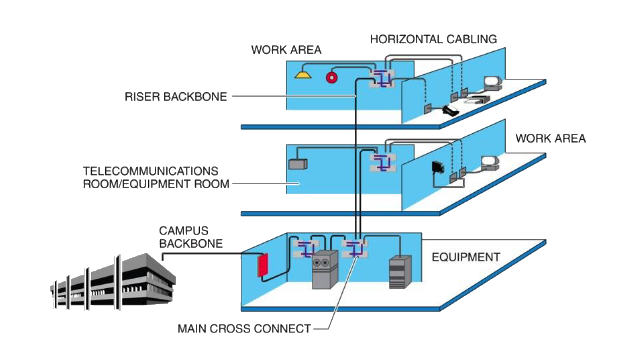
How Proper Cabling Improves Network Efficiency and Reduces Downtime
While organizations often invest heavily in servers, cloud solutions, and cybersecurity, one fundamental element is frequently overlooked—network cabling. In fact, research shows that nearly 70% of network-related issues stem from poor cabling practices. This staggering statistic highlights how essential structured cabling is to ensure speed, reliability, and minimal downtime.
Much like plumbing in a building, cabling forms the foundation of an IT infrastructure. Poorly installed or unmanaged cables are like leaky pipes—they cause bottlenecks, interruptions, and costly inefficiencies. On the other hand, proper cabling practices—structured layouts, labeling, and high-quality materials—can transform network performance, making troubleshooting easier and reducing operational costs.
This blog explores why structured cabling matters, how it impacts efficiency, and the practical best practices that businesses can adopt to avoid costly downtime.
1. Why Cabling Matters in Business Networks
Cabling is often seen as the “invisible” part of IT infrastructure. Once cables are hidden in walls, under floors, or bundled into server racks, businesses tend to forget about them. Yet, they play a pivotal role in determining:
-
Network Speed: High-quality fiber optic or Cat6/Cat6a copper cables ensure fast data transfer with minimal latency.
-
Reliability: Well-installed cables reduce packet loss, interference, and connection failures.
-
Uptime: Organized and labeled cabling minimizes downtime during troubleshooting.
-
Scalability: Structured cabling makes it easier to expand networks as a business grows.
Think of cabling as the circulatory system of your business IT infrastructure—if it’s weak or disorganized, the entire operation suffers.
2. The Hidden Costs of Poor Cabling
Businesses that ignore proper cabling often face problems that go beyond minor inconveniences:
-
Frequent Downtime: Unstable connections lead to outages, disrupting operations and customer service.
-
Higher Maintenance Costs: IT teams waste hours tracing messy cables to find faults.
-
Slower Troubleshooting: Without labeling, a simple port change can take hours.
-
Lost Productivity: Employees lose valuable time waiting for slow or unstable connections.
-
Customer Dissatisfaction: Retailers, banks, and healthcare providers risk losing trust if their systems crash.
📌 Case Example: A retail chain in the U.S. reported 40% fewer internet outages after migrating to a structured cabling system, which directly improved customer experience and boosted sales.
3. Benefits of Proper Cabling
When businesses invest in structured cabling, the benefits are immediate and long-lasting:
✅ Improved Network Efficiency
Organized cabling ensures smooth data flow, reduces interference, and optimizes bandwidth usage.
✅ Reduced Downtime
Since issues can be quickly identified and resolved, networks stay up longer, saving thousands in lost productivity.
✅ Easier Scalability
Businesses can add new devices, workstations, or servers without overhauling the entire infrastructure.
✅ Cost Savings
Though structured cabling requires upfront investment, it significantly lowers maintenance costs and prevents expensive outages.
✅ Enhanced Workplace Safety
Properly managed cables prevent trip hazards, overheating, and fire risks associated with tangled or overloaded wiring.
📌 Case Example: An IT team saved dozens of troubleshooting hours per month simply because cables were labeled and organized correctly.
4. Cabling Best Practices for Businesses
To achieve the benefits above, organizations should adopt the following practices:
-
Invest in Quality Cables
-
Use Cat6/Cat6a for copper connections or fiber optic cabling for high-speed and long-distance data transfer.
-
-
Implement Structured Cabling Systems
-
Avoid ad hoc cabling; follow standardized layouts with proper racks, patch panels, and cable trays.
-
-
Label Everything
-
Label cables, ports, and racks for quick identification during troubleshooting.
-
-
Plan for Scalability
-
Install additional conduits and ports for future growth, reducing costs in the long run.
-
-
Ensure Proper Cable Management
-
Use Velcro ties (not zip ties) to bundle cables neatly and avoid strain or damage.
-
-
Follow Standards (TIA/EIA-568)
-
Adhering to industry standards ensures consistency, compatibility, and reliability.
-
-
Regular Audits & Testing
-
Periodically check cable performance and replace damaged or outdated cabling.
-
5. Structured Cabling vs. Traditional Point-to-Point Cabling
| Aspect | Structured Cabling | Traditional Cabling |
|---|---|---|
| Organization | Centralized, well-labeled | Messy, ad hoc |
| Scalability | Easily expandable | Difficult and costly |
| Troubleshooting | Fast and efficient | Time-consuming |
| Reliability | Higher uptime | Frequent downtime |
| Long-Term Cost | Lower overall | Higher due to maintenance |
Clearly, structured cabling offers superior reliability, flexibility, and cost savings, making it the smarter choice for modern businesses.
6. The ROI of Proper Cabling
While some business leaders hesitate to spend on cabling, the return on investment is significant:
-
Fewer Outages = More Revenue: Prevents lost sales in retail, banking, and e-commerce.
-
Lower IT Costs: Reduces hours wasted in troubleshooting.
-
Employee Productivity: Stable internet and network speeds ensure uninterrupted workflows.
-
Future-Proofing: Supports upgrades like IoT devices, 5G integration, and cloud-based services.
In essence, structured cabling isn’t just a technical investment—it’s a strategic business decision.
Conclusion
Network efficiency and uptime are critical to every business, from retail stores to enterprise data centers. While servers, software, and cybersecurity get the spotlight, cabling is the unsung hero of IT infrastructure. Proper cabling practices—structured layouts, labeling, scalability planning, and adherence to standards—drastically reduce downtime and improve efficiency.
As the saying goes: “A network is only as strong as the cables behind it.” Businesses that invest in structured cabling today will enjoy smoother operations, faster troubleshooting, and long-term cost savings tomorrow.